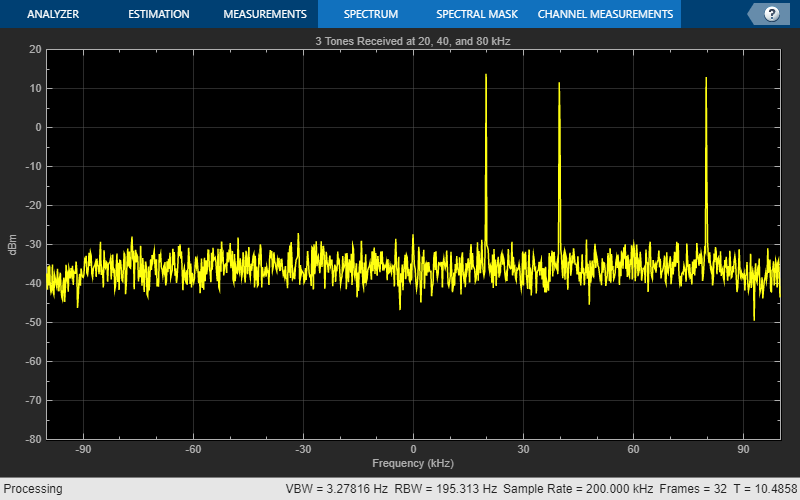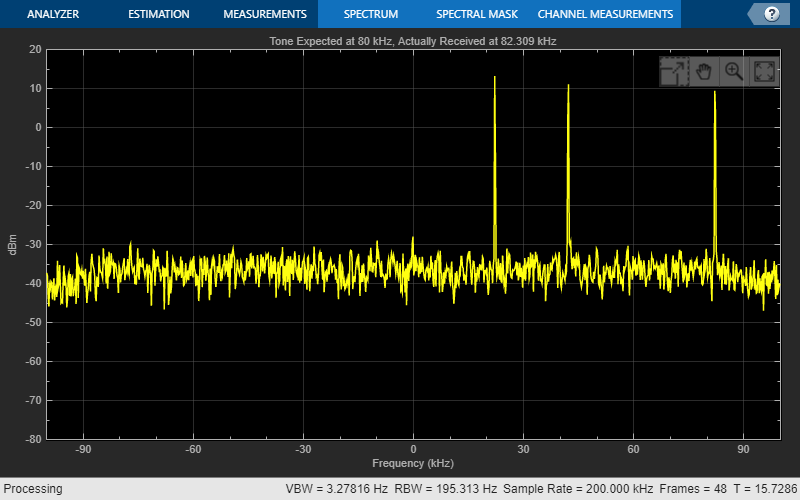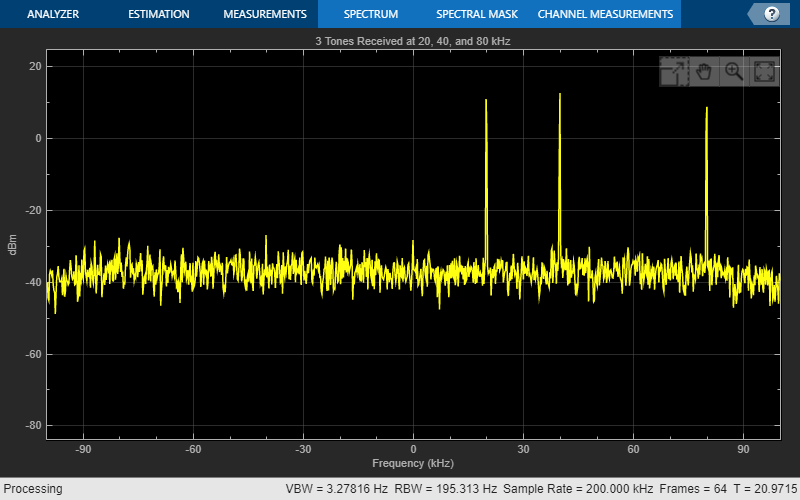Frequency Correction for ADALM-PLUTO Radio
This example shows how to synchronize both the baseband sample rate and the center frequency of two PlutoSDRs by using the FrequencyCorrection property of comm.SDRRxPluto and comm.SDRTxPluto.
The baseband sample rate and the center frequency of a PlutoSDR are physically derived from the same oscillator. Although each PlutoSDR is factory-calibrated to use appropriate PLL settings to digitally compensate for component variations of the oscillator, the compensation is imperfect because of quantization effects and changes in operating conditions (temperature in particular). Consequently, two PlutoSDRs will operate at slightly different baseband sample rates and center frequencies even if the corresponding System objects for the two PlutoSDRs use the same values for the BasebandSampleRate and CenterFrequency properties. To solve this problem, the FrequencyCorrection property of comm.SDRRxPluto and comm.SDRTxPluto can be used.
The FrequencyCorrection property specifies the parts-per-million change to the baseband sample rate and the center frequency. The default value is 0, which means that the radio will use its factory-calibrated PLL settings. In this example, we treat one PlutoSDR, the transmitter, as a source with accurate baseband sample rate and center frequency. We use the signal received by another PlutoSDR, the receiver, to estimate the right value of FrequencyCorrection for the receiver System object, and show that when FrequencyCorrection is set appropriately, the frequency offset between the transmitter and the receiver will be removed almost completely.
Refer to the Guided Host-Radio Hardware Setup documentation for details on configuring your host computer to work with the PlutoSDR.
Algorithm for Estimating Frequency Correction
Consider a signal transmitted from one PlutoSDR to another PlutoSDR. Let  and
and  be the center frequency and the baseband sample rate of the transmitter. Let
be the center frequency and the baseband sample rate of the transmitter. Let  and
and  be the center frequency and the baseband sample rate of the receiver. Assume that the oscillator of the transmitter has not drifted and the oscillator of the receiver has drifted by a factor
be the center frequency and the baseband sample rate of the receiver. Assume that the oscillator of the transmitter has not drifted and the oscillator of the receiver has drifted by a factor  , i.e.
, i.e.  and
and  where
where  is a number very close to 1.
is a number very close to 1.
A tone at baseband frequency  in the transmitted signal will appear as a tone at baseband frequency
in the transmitted signal will appear as a tone at baseband frequency  in the receiver, where
in the receiver, where  . The term
. The term  in the numerator is due to the mismatch in center frequencies. The scaling factor
in the numerator is due to the mismatch in center frequencies. The scaling factor  in the denominator is due to the mismatch in baseband sample rates. Hence, we can solve for
in the denominator is due to the mismatch in baseband sample rates. Hence, we can solve for  with
with  ,
,  , and
, and  .
.  .
.
To remove the frequency offset between the transmitter and the receiver, we need to scale the baseband sample rate and the center frequency of the receiver by a factor of  . Let
. Let  be the parts-per-million change to the baseband sample rate and the center frequency of the receiver. Then
be the parts-per-million change to the baseband sample rate and the center frequency of the receiver. Then  . Therefore
. Therefore  .
.
Set up the Transmitter and the Receiver
We use one PlutoSDR to transmit three tones at 20, 40, and 80 kHz. The tone at 80 kHz is used to estimate the value for FrequencyCorrection for the receiver. The tones at 20 and 40 kHz are only used to help visualize the spectrum.
% Set up parameters and signals sampleRate = 200e3; centerFreq = 2.42e9; fRef = 80e3; s1 = exp(1j*2*pi*20e3*[0:10000-1]'/sampleRate); % 20 kHz s2 = exp(1j*2*pi*40e3*[0:10000-1]'/sampleRate); % 40 kHz s3 = exp(1j*2*pi*fRef*[0:10000-1]'/sampleRate); % 80 kHz s = s1 + s2 + s3; s = 0.6*s/max(abs(s)); % Scale signal to avoid clipping in the time domain % Set up the transmitter % Use the default value of 0 for FrequencyCorrection, which corresponds to % the factory-calibrated condition tx = sdrtx('Pluto', 'RadioID', 'usb:1', 'CenterFrequency', centerFreq, ... 'BasebandSampleRate', sampleRate, 'Gain', 0, ... 'ShowAdvancedProperties', true); % Use the info method to show the actual values of various hardware-related % properties txRadioInfo = info(tx) % Send signals disp('Send 3 tones at 20, 40, and 80 kHz'); transmitRepeat(tx, s); % Set up the receiver % Use the default value of 0 for FrequencyCorrection, which corresponds to % the factory-calibrated condition numSamples = 1024*1024; rx = sdrrx('Pluto', 'RadioID', 'usb:0', 'CenterFrequency', centerFreq, ... 'BasebandSampleRate', sampleRate, 'SamplesPerFrame', numSamples, ... 'OutputDataType', 'double', 'ShowAdvancedProperties', true); % Use the info method to show the actual values of various hardware-related % properties rxRadioInfo = info(rx)
## Establishing connection to hardware. This process can take several seconds.
txRadioInfo =
struct with fields:
Status: 'Full information'
CenterFrequency: 2.4200e+09
BasebandSampleRate: 200000
SerialNum: '10447354119600021d001f000af61ec621'
Gain: 0
RadioFirmwareVersion: "0.34"
ExpectedFirmwareVersion: "0.34"
HardwareVersion: "B1"
FrequencyCorrection: 0
Send 3 tones at 20, 40, and 80 kHz
## Establishing connection to hardware. This process can take several seconds.
## Waveform transmission has started successfully and will repeat indefinitely.
## Call the release method to stop the transmission.
## Establishing connection to hardware. This process can take several seconds.
Warning: ADALM-PLUTO radio with serial number
'1044734c9605001118000d00408f4fdca4' has firmware version "0.31". You can
continue using version "0.31", with the understanding that this release of the
support package was tested with version "0.34". If you experience unexpected
behavior while using version "0.31", we recommend installing version "0.34". To
switch the firmware version to "0.34", release the System object, then click <a
href="matlab:plutoradio.internal.openHSA;">here</a> to start the Hardware Setup
App.
rxRadioInfo =
struct with fields:
Status: 'Full information'
CenterFrequency: 2.4200e+09
BasebandSampleRate: 199999
SerialNum: '1044734c9605001118000d00408f4fdca4'
GainControlMode: 'AGC Slow Attack'
RadioFirmwareVersion: "0.31"
ExpectedFirmwareVersion: "0.34"
HardwareVersion: "B0"
EnableQuadratureTracking: 1
EnableRFDCTracking: 1
EnableBasebandDCTracking: 1
FrequencyCorrection: 0
Receive and Visualize Signal
disp(['Capture signal and observe the frequency offset' newline]) receivedSig = rx(); % Find the tone that corresponds to the 80 kHz transmitted tone y = fftshift(abs(fft(receivedSig))); [~, idx] = findpeaks(y,'MinPeakProminence',max(0.5*y)); fReceived = (max(idx)-numSamples/2-1)/numSamples*sampleRate; % Plot the spectrum sa = spectrumAnalyzer('SampleRate', sampleRate); sa.Title = sprintf('Tone Expected at 80 kHz, Actually Received at %.3f kHz', ... fReceived/1000); receivedSig = reshape(receivedSig, [], 16); % Reshape into 16 columns for i = 1:size(receivedSig, 2) sa(receivedSig(:,i)); end
Capture signal and observe the frequency offset ## Establishing connection to hardware. This process can take several seconds. Warning: ADALM-PLUTO radio with serial number '1044734c9605001118000d00408f4fdca4' has firmware version "0.31". You can continue using version "0.31", with the understanding that this release of the support package was tested with version "0.34". If you experience unexpected behavior while using version "0.31", we recommend installing version "0.34". To switch the firmware version to "0.34", release the System object, then click <a href="matlab:plutoradio.internal.openHSA;">here</a> to start the Hardware Setup App.

Estimate and Apply the Value of FrequencyCorrection
rx.FrequencyCorrection = (fReceived - fRef) / (centerFreq + fRef) * 1e6; msg = sprintf(['Based on the tone detected at %.3f kHz, ' ... 'FrequencyCorrection of the receiver should be set to %.4f'], ... fReceived/1000, rx.FrequencyCorrection); disp(msg); rxRadioInfo = info(rx)
Based on the tone detected at 60.093 kHz, FrequencyCorrection of the receiver should be set to -8.2256
rxRadioInfo =
struct with fields:
Status: 'Full information'
CenterFrequency: 2.4200e+09
BasebandSampleRate: 199999
SerialNum: '1044734c9605001118000d00408f4fdca4'
GainControlMode: 'AGC Slow Attack'
RadioFirmwareVersion: "0.31"
ExpectedFirmwareVersion: "0.34"
HardwareVersion: "B0"
EnableQuadratureTracking: 1
EnableRFDCTracking: 1
EnableBasebandDCTracking: 1
FrequencyCorrection: -8.2250
Receive and Visualize Signal
% Capture 10 frames, but only use the last frame to skip the transient % effects due to changing FrequencyCorrection disp(['Capture signal and verify frequency correction' newline]) for i = 1:10 receivedSig = rx(); end % Find the tone that corresponds to the 80 kHz transmitted tone % fReceived2 should be very close to 80 kHz y = fftshift(abs(fft(receivedSig))); [~,idx] = findpeaks(y,'MinPeakProminence',max(0.5*y)); fReceived2 = (max(idx)-numSamples/2-1)/numSamples*sampleRate; % Plot the spectrum sa.Title = '3 Tones Received at 20, 40, and 80 kHz'; receivedSig = reshape(receivedSig, [], 16); % Reshape into 16 columns for i = 1:size(receivedSig, 2) sa(receivedSig(:,i)); end msg = sprintf('Tone detected at %.3f kHz\n', fReceived2/1000); disp(msg);
Capture signal and verify frequency correction Tone detected at 79.916 kHz

Change FrequencyCorrection of the Transmitter
Now we change the FrequencyCorrection property of the transmitter to simulate the effect that the transmitter's oscillator has drifted.
disp(['Change the FrequencyCorrection property of the transmitter to 1 to ' ... 'simulate the effect that the transmitter''s oscillator has drifted']) tx.FrequencyCorrection = 1; % 1 ppm txRadioInfo = info(tx) tx.transmitRepeat(s);
Change the FrequencyCorrection property of the transmitter to 1 to simulate the effect that the transmitter's oscillator has drifted
txRadioInfo =
struct with fields:
Status: 'Full information'
CenterFrequency: 2.4200e+09
BasebandSampleRate: 200000
SerialNum: '10447354119600021d001f000af61ec621'
Gain: 0
RadioFirmwareVersion: "0.34"
ExpectedFirmwareVersion: "0.34"
HardwareVersion: "B1"
FrequencyCorrection: 1.0000
## Waveform transmission has started successfully and will repeat indefinitely.
## Call the release method to stop the transmission.
Receive and Visualize Signal
% Capture 10 frames, but use the last frame only to skip the transient % effects due to changing FrequencyCorrection disp(['Capture signal and observe the frequency offset' newline]) for i = 1:10 receivedSig = rx(); end % Find the tone that corresponds to the 80 kHz transmitted tone % fReceived3 will not be close to 80 kHz because tx.FrequencyCorrection % has been changed y = fftshift(abs(fft(receivedSig))); [~,idx] = findpeaks(y,'MinPeakProminence',max(0.5*y)); fReceived3 = (max(idx)-numSamples/2-1)/numSamples*sampleRate; % Plot the spectrum sa.Title = sprintf('Tone Expected at 80 kHz, Actually Received at %.3f kHz', ... fReceived3/1000); receivedSig = reshape(receivedSig, [], 16); % Reshape into 16 columns for i = 1:size(receivedSig, 2) sa(receivedSig(:,i)); end
Capture signal and observe the frequency offset

Estimate and Apply the Value of FrequencyCorrection
We use the same method to estimate the required parts-per-million change to the baseband sample rate and the center frequency of the receiver. However, the estimated value needs to be combined appropriately with the current setting of FrequencyCorrection, which is nonzero. Since  , applying two changes
, applying two changes  and
and  successively is equivalent to applying a single change of
successively is equivalent to applying a single change of  with respect to the factory-calibrated condition.
with respect to the factory-calibrated condition.
rxRadioInfo = info(rx); currentPPM = rxRadioInfo.FrequencyCorrection; ppmToAdd = (fReceived3 - fRef) / (centerFreq + fRef) * 1e6; rx.FrequencyCorrection = currentPPM + ppmToAdd + currentPPM*ppmToAdd/1e6; msg = sprintf(['Based on the tone detected at %.3f kHz, ' ... 'FrequencyCorrection of the receiver should be changed from %.4f to %.4f'], ... fReceived3/1000, currentPPM, rx.FrequencyCorrection); disp(msg); rxRadioInfo = info(rx)
Based on the tone detected at 82.309 kHz, FrequencyCorrection of the receiver should be changed from -8.2250 to -7.2709
rxRadioInfo =
struct with fields:
Status: 'Full information'
CenterFrequency: 2.4200e+09
BasebandSampleRate: 200000
SerialNum: '1044734c9605001118000d00408f4fdca4'
GainControlMode: 'AGC Slow Attack'
RadioFirmwareVersion: "0.31"
ExpectedFirmwareVersion: "0.34"
HardwareVersion: "B0"
EnableQuadratureTracking: 1
EnableRFDCTracking: 1
EnableBasebandDCTracking: 1
FrequencyCorrection: -7.2750
Receive and Visualize Signal
% Capture 10 frames, but use the last frame only to skip the transient % effects due to changing FrequencyCorrection disp(['Capture signal and verify frequency correction' newline]) for i = 1:10 receivedSig = rx(); end % Find the tone that corresponds to the 80 kHz transmitted tone % fReceived4 should be very close to 80 kHz y = fftshift(abs(fft(receivedSig))); [~,idx] = findpeaks(y,'MinPeakProminence',max(0.5*y)); fReceived4 = (max(idx)-numSamples/2-1)/numSamples*sampleRate; % Plot the spectrum sa.Title = '3 Tones Received at 20, 40, and 80 kHz'; receivedSig = reshape(receivedSig, [], 16); % Reshape into 16 columns for i = 1:size(receivedSig, 2) sa(receivedSig(:,i)); end msg = sprintf('Tone detected at %.3f kHz', fReceived4/1000); disp(msg); % Release the radios release(tx); release(rx);
Capture signal and verify frequency correction Tone detected at 79.994 kHz

